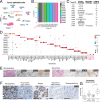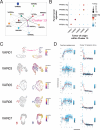Bladder cancer variants share aggressive features including a CA125+ cell state and targetable TM4SF1 expression
- PMID: 40527915
- PMCID: PMC12174346
- DOI: 10.1038/s41467-025-59888-8
Bladder cancer variants share aggressive features including a CA125+ cell state and targetable TM4SF1 expression
Abstract
Histologic variant (HV) subtypes of bladder cancer are clinically aggressive tumors that are more resistant to standard therapy compared to conventional urothelial carcinoma (UC). Little is known about the transcriptional programs that account for their biological differences. Here we show using single cell analysis that HVs harbor a tumor cell state characterized by expression of MUC16 (CA125), MUC4, and KRT24. This cell state is enriched in metastases, predicted to be highly resistant to chemotherapy, and linked with poor survival. We also find enriched expression of TM4SF1, a transmembrane protein, in HV tumor cells. Chimeric antigen receptor (CAR) T cells engineered against TM4SF1 protein demonstrated in vitro and in vivo activity against bladder cancer cell lines in a TM4SF1 expression-dependent manner, highlighting its potential as a therapeutic target.
© 2025. This is a U.S. Government work and not under copyright protection in the US; foreign copyright protection may apply.
Conflict of interest statement
Competing interests: J.C. and F.H. are inventors on a patent application related to the CAR T cell technology described in this manuscript (“TM4SF1 CAR CELLS AND METHODS OF USE THEREOF”, U.S. Patent Application No. 63/649,157, U.S. Patent Application No. 63/649,821). The remaining authors declare no competing interests.
Figures





References
-
- Lobo, N. et al. What is the significance of variant histology in urothelial carcinoma?. Eur. Urol. Focus6, 653–663 (2020). - PubMed
-
- Humphrey, P. A., Moch, H., Cubilla, A. L., Ulbright, T. M. & Reuter, V. E. The 2016 WHO classification of tumours of the urinary system and male genital organs—Part B: Prostate and bladder tumours. Eur. Urol.70, 106–119 (2016). - PubMed
-
- Porten, S. P., Willis, D. & Kamat, A. M. Variant histology: role in management and prognosis of nonmuscle invasive bladder cancer. Curr. Opin. Urol.24, 517–523 (2014). - PubMed
-
- Willis, D. L., Porten, S. P. & Kamat, A. M. Should histologic variants alter definitive treatment of bladder cancer?. Curr. Opin. Urol.23, 435–443 (2013). - PubMed
MeSH terms
Substances
LinkOut - more resources
Full Text Sources
Medical
Research Materials
Miscellaneous

